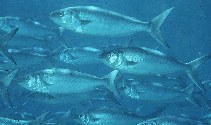 The Kahawai is a schooling pelagic fish and inhabits the continental
shelf waters around the coasts of New Zealand fron the far north to the deep south, down to a depth of around 30 metres.
The Kahawai is a schooling pelagic fish and inhabits the continental
shelf waters around the coasts of New Zealand fron the far north to the deep south, down to a depth of around 30 metres.
It can be found almost anywhere, from the inside of estuaries, bays and inlets, to the reefs and coastal beaches where the adults move, and are quite offten seen in large schools along the shores.
In the far north of New Zealand around Spirits Bay and the Cape exceptionally large specimens are sometimes caught that may be up to 1 metre, or 3 ft in length and weigh 15kg or 33 lbs. These individuals are often mistaken for kingfish. This is more the exeption than the norm.
Some individuals swim separately, though normally they swim in schools from a dozen or more up to hundreds.
Like other pelagic fish the kahawai has a solid body with strong swimming muscles.It is a dark blue-green colour above and silvery below, with irregularly defined spots arranged laterally in indistinct rows along it's sides.
They grow to a maximim length of 75cm although they are normally found around the 50cm size.
Kahawai can live up to be 25 years old.
They eat other smaller pelagic fish such as sprats, pilchards etc and some food found on the sea floor, and as I have since found out they like small crustations like krill. Often when feeding Kahawai use a herding technique. They force their prey to the surface and feed on them up while poking their backs high out above the water. They dart in feeding and repeat the process thus keeping their prey together. You will often see seabirds gathering together over this area to join in the feeding frenzy whenever they get the chance.
The Kahawai spawn on the sea bed between 60 and 100mts deep. The eggs are pelagic. Juvenile fish under a year old can be found in shallow water over eelgrass, and estuaries.
Kahawai spawn in the summer months in the warmer shallow waters bewteen March and april. They move into these shallow waters in huge schools. In late summer the small 1mm in size eggs are found in the shallow water and hatch within two days of fertilisation.
During the winter months the kahawai are found more commonly in the deeper water further offshore.